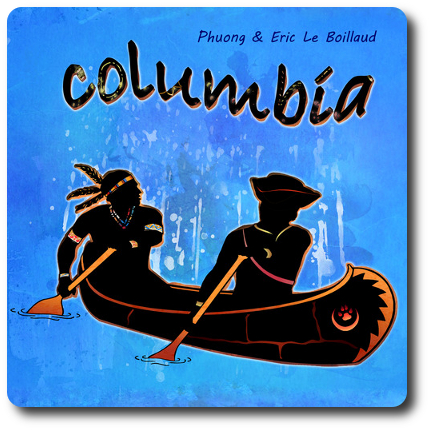
The Basics:
- For ages 8 and up (publisher suggests 12+)
- For 2 to 5 players
- Approximately 45 minutes to complete
Geek Skills:
- Counting & Math
- Logical & Critical Decision Making
- Pattern/Color Matching
- Strategy & Tactics
- Hand/Resource Management
Learning Curve:
- Child – Easy
- Adult – Easy
Theme & Narrative:
- Be smarter than the average bear as you trap said bear for profit
Endorsements:
- Gamer Geek approved!
- Parent Geek approved!
- Child Geek approved!
Overview
In the 17th and 18th century, North American was seen as a land full of adventure and profit. Two great companies saw this clearer than anyone and established fur trading posts up and down major water thoroughfares to capitalize on the territory’s vast wealth of resources. Many came to try their hand at trapping and trading in hopes of making a fortune. You are one of those hopeful individuals. If you are smart, you will be rich, but you’ll need your wits about you to defeat the competition!
Columbia, designed by Eric Le Boillaud and Phuong Le Boillaud, and published by the Game Crafter, is comprised of 78 Expedition cards (24 Trap cards, 16 Barter cards, 18 Canoe cards, and 20 Sales cards), 24 Trading Post cards (12 North West Company blue cards and 12 Hudson’s Bay Company red cards), 5 River cards (in 5 different colors), 50 Animal Fur cubes (orange for beaver, white for wolf, and black for bear), 45 coins (in colors green, purple, and gold representing 1, 5, and 10 pounds of pure fur trading profit), and 1 turn marker. The cards are of typical standard card stock, the coins look a bit out of place (colorwise) but work very well, and the little wood cubes are wooden and cubish. No surprises here, folks. What is a wonderful surprise is the artwork, by Phuong Le Boillaud, that is done in a petroglyphic illustration style. Cool, yeah? Get’s cooler. Each image not only provides information to the players, but is also used in game play to represent specific placement spots for cubes and collection of cube colors. A unique game design that allows the game to play with the cards as if it they were little game boards.
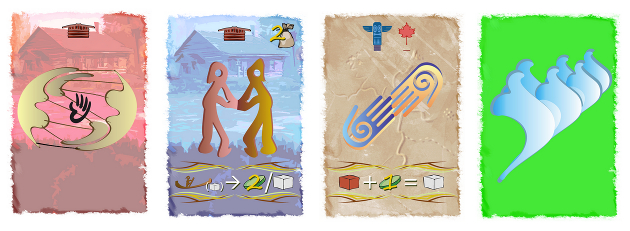
From left to right: Hudson’s Bay Company, North West Company, Expedition, and River card
Game Set Up
Note: the standard game is for 2 to 3 players. The Game Variant section below will detail the differences for a 4 to 5-player game.
To set up the game, first sort all the coins and the cubes. Places these to the side of the playing area. We suggest you let one player be the “banker” as it makes the game go much faster and keeps the table organized. The coins and cubes kept to the side of the game playing area are referred to as the “General Stock”.
Second, sort the cards into three different decks. The first deck will be all the blue North West Company cards, the second deck will be the red Hudson’s Bay Company cards, and the third deck will be the tan Expedition cards.
Third, shuffle both the North West Company and the Hudson’s Bay Company decks separately and then deal out 6 cards on the table from both decks. Arrange these 12 cards in a single row, face-up, and alternating in color (red, blue, red, blue, etc.) in the middle of the playing area. Place the turn marker next to the furthest left card. Place the remaining Trading Post cards back in the game box.
Fourth, shuffle the Expedition cards and deal to each player 5 cards each, face-down. Players should look at their cards, but should keep them hidden from their opponents. Place the Expedition deck face-down and within easy reach of all the players. We suggest you place the deck on the far left side of the Trading Post card’s row. This serves as an excellent reminder to everyone which side of the row is the left side.
Fifth, hand to each player a River card, which is placed face-up on the player’s left side of their playing area directly in front of them. This card is referred to as the player’s “Camp” even though it is clearly a river. Hand to each player 2 purple coins (worth 5 pounds each, for t total of 10 pounds).
That’s it for game set up! Let’s go trap us some fun!
Trapping Like a Boss
The game is played in turns with 13 turns in total. Each round is comprised of a number of phases. These phases are summarized here. All players play at the same time during each of the phases.
First Turn Phase
The very first turn of the game is a special phase and replaces the Expedition phase for the first game turn only.
During this phase, all the players lay down all 5 of their Expedition cards, face-down, in order from left to right starting from the space directly right of the player’s own Camp. Order is exceedingly important because cards will “roll off” as the game progresses, shifting to the left with the left most card (next to the Camp) being discarded. This is explained in more detail in the Winter Phase. Once the players have all placed their cards, they are revealed by turning them face-up.
Each Expedition card has a coin symbol in the card’s upper left corner. The number on the coin symbol represents the card’s cost in pounds. All the players now pay the sum amount of the cards played to the table using their coins. All payment goes back to the General Stock. Players are always welcome to make change using what coins are available in the General Stock. This is why we recommend one player be the “banker”. After all the players have paid, each gets a new hand of 4 Expedition cards.
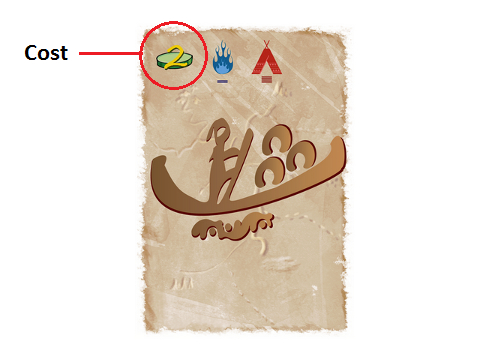
Note that the coins in the game are used as currency and victory points. If a player is ever unable to pay the full cost of a card, they still pay for is using as many of their coins as possible, even if they come up short. For example, if a card costs 3 pounds to play, but the player only has 2 pounds available, they pay the 2 pounds and play the card. If the player had no coins, they could still play the card, but pay nothing as a result of being dead broke.
Expedition Phase
The Expedition phase starts turns 2 through 13 and is replaced by the First Turn phase during the game’s first turn only.
During this phase, the first action is to move the turn marker to the next most right blue or red Trading Post card. This is why we suggest you place the Expedition deck on the left side of the Trading Post card row. The turn marker identifies which card in the row will be available to a player to claim, but not yet. First the player has to do some strategic thinking.
Before each player are 4 Expedition cards (you always lose one during the Winter Phase). On each of the Expedition cards is a blue and a red symbol located on the top center of the card. These symbols are used to create Poker like hands using the 4 visible Expedition cards and 1 Expedition card in the player’s hand.

Whatever color Trading Post card the turn marker is on identifies the color of the symbols to be used during this turn. For example, if the turn marker was on a blue North West Company card, only the blue symbols will be used during this turn (red being ignored). The possible hands are as follows.
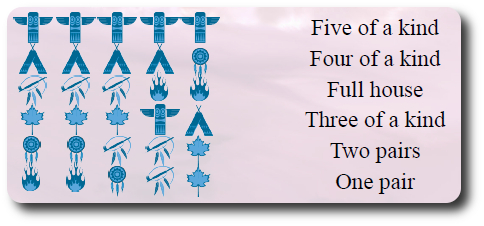
Additionally, the symbols used have a ranking hierarchy that helps break ties or matched card hands of the same type. Note that each symbol has 1 to 6 small lines underneath it. These are included for quick reference during game play to help determine the symbol’s ranking.
![]()
Players select one of their cards in their hand and place it down next to the rightmost Expedition card in front of them, face-down. When all the players have placed their card, they are revealed and placed face-up to create a row of 5 cards in front of each player. Payment for the card played is then completed using the coins.
All the players now attempt to make the best card hand out of what they have. Card order doesn’t make any difference, but players should not shift their cards around. The player with the best combination of colored symbols on their face-up Expedition cards wins and now collects the Trading Post card next to the turn marker. This card is placed face-up above the player’s Expedition cards and can now be used by the player for the duration of the game. No other player can use this card and the Trading Post card is worth victory points at the end of the game.
Trading Phase
During this phase, the player will be able to take up to 2 different actions (cannot perform the same action twice) and in any order they like. What actions they can take and when will depend on what cards they have in front of them. Players are never forced to take both of their actions if they don’t want to. Each of the actions are summarized here.
- Trap: this action allows the player to place one Animal Fur cube on every empty animal print that the player has on their Trap cards. The cubes are taken from the General Stock and should match the color of the animal print. Multiple Trap cards and multiple animal prints on Trap cards are all filled during this single action, but only if the cubes are available. There are only so many animals, after all.
- Transport: this action allows the player to fill their Canoe cards with the Animal Fur cubes. Each Canoe card will show 1, 2, or 3 “bales”. Players can fill 1, 2, or all 3 the bales on every Canoe card they have, but the Animal Fur cubes on the Canoe card must be the same color. For example, a Canoe card could hold 3 white cubes, but not 1 white, 1 black, and 1 orange cube.
- Swap: this action allows the player to exchange cube colors for different cube colors. On each of the Barter cards will be a combination of a specific colored cube plus so many coins that can be placed in the General Stock to retrieve 1 cube of a specific color. Players are always trading up, but the cost of the trade is always determined by the Barter card. Swapped cubes can come from the player’s Trap or Canoe cards. The newly acquired cube must be placed on a free animal print on a Trap that matches the cube’s color or on a Canoe that allows for the newly acquired cube.
- Sell: this action allows the player to sell their cubes for coins. Selling is done in the same way as swapping, but only cubes in a player’s Canoe cards can be used. For every specific colored cube the player has in a Canoe card, a specific number of coins is given as payment. The cubes sold are returned to the General Stock and any coins earned during the transaction are collected by the player from the General Stock. How many coins a player has is public knowledge. As such, players should keep their coins out in front of them at all times.
A player can mix the actions they take every time a new Trading Phase starts. For example, the player could spend the first turn using the Trap and Transport actions, and the next turn they might use the Trap and Swap actions.
Winter Phase
During this phase, each player discards the Expedition card closest to their River card, returning any cubes that might be on it to the General Stock. OUCH! Then the remaining 4 cards in front of the player are shifted one space to the left towards their River card. Any cubes on these cards remain. Any Trading Post cards the player might have won during the Expedition Phase also remain (these cards are never lost). Finally, each player draws 1 Expedition card bringing their hand size back up to 4 cards. Discarded cards should all be placed in a discard pile off to one side of the game playing area.
This ends the turn. A new turn now begins unless this was the 13th and final turn.
Ending the Game
The game ends on the 13th turn after the Winter Phase. Each player now counts up their points.
- Add up the victory point values of all the Trading Post cards
- Add up the victory point values of each of the coins (1 point per pound) still in the player’s possession
- 1 victory point for every 2 cubes of any color still in the player’s possession
All the above are then added together to find the player’ final score. The player with the highest score wins the game!
Game Variant
To play a 4 to 5-player game, the game set up and a few of the turn phases are slightly different from the above noted 2 to 3-player game. The changes are summarized here.
- Instead of a single row of 12 alternating colored Trading Post cards, during the game set up deal out 2 rows of all 24 Trading cards (one color per row). This will result in there being one row being comprised of 12 blue Trading Post cards and another row (right above or below it) that is comprised of 12 red Trading Post cards.
- During the Expedition Phase, the turn marker identifies the pair of Trading Post cards (1 red and 1 blue) that will be up for grabs. Players select and play their 5th Expedition card as normal, but the player with the highest blue hand takes the blue Trading Post card and the player with the highest red hand takes the red Trading Post card. It is perfectly possible that both cards go to the same player!
- During the Winter Phase, if the Expedition deck is ever exhausted, collect the discarded Expedition cards and shuffle them to create the new Expedition deck to draw from.
To learn more about Columbia and read the full rules, visit the game’s web page on the Game Crafter.
Prediction
There’s a lot going on in Columbia that might not be readily obvious from just reading the game rules. First off, managing cards is going to be a big “must” for the players. Not only does each card represent the actions the player can take, but they are also used to help win the Trading Post cards. Second, each Expedition card costs coins which are also victory points and are necessary to help pay for certain actions!
This all sounds very involved, and it is, but the game’s phases during a single turn are very straight forward and simple to follow. This means it will also be simple to teach. Even better, the game’s level of player interaction is slight but the competition between the players is pretty intense. Should result in some interesting passive-aggressive game play!
I predict Columbia will be a hit for the older Gamer Geeks and the Parent Geeks, alike. I think the non-gamers won’t warm up to the game right away, but they should be able to play and enjoy the game with little effort on their part. I have no doubt in my mind that the Gamer Geeks are also going to enjoy Columbia. It’s a tight little game with a lot of depth, hand management, and lends itself well to individual player strategy and tactics. Yes, I see this game doing very well with everyone we play it with.
Teaching the game takes about 10 minutes, which is slightly longer than I would expect for a game of this size. Most my focus was on the importance of playing cards right, affording them, and then utilizing them for their maximum benefit before they roll off and are lost. It is very important to make sure that each player understands each of the four actions and the necessary materials needed before each action can be triggered. Most of the questions asked were focused on the Trading Post cards. Specifically, what the difference was between them and the Expedition cards. Simply put, the Expedition cards are abundant, but do not last. A player will only have access to any one Expedition card for a maximum of 5 rounds. The Trading Post cards are permanent, and the sooner they are won, the sooner they can be utilized. The Trading Post cards also provide victory points and focus on specific actions (North West Company focuses on transporting and selling of furs, while the Hudson’s Bay Company focuses on trapping and victory points). In essence, the players are somewhat “building” permanent actions, but the players are always competing for them.
And so, after teaching the game to my oldest little geek (my 5-year-old didn’t show much interest in it and preferred to help me play other games), I asked him his thoughts on the game so far.
“A really neat idea for a card game. I really like how everything keeps changing. Should be a fun challenge!” ~ Liam (age 8)
I agree! I’m very curious to see how the game “feels” when we are playing it. Will it feel like a game I can control and take action on or will the game feel chaotic and I will be spending most of my efforts reacting to the changes? Only one way to find out! Let’s play Columbia and see if the game is well worth the trip or the game is up the river without a paddle.
Final Word
The older Child Geeks enjoyed themselves during this game, but it took them a few turns to get the hang of it. The most frustrating part of the game for them was attempting to make card hands. For those Child Geeks who had played enough card games before, knowing Poker hands and which ones were better wasn’t that much of an issue. For the others, it became clear a player’s aid was necessary to help them organize their hand and be more successful during the Expedition phase. All I did was copy/paste the images available from the downloadable rule book and printed them off for each player. This solved the problem and each of the Child Geeks were able to play a much stronger game as a result. Victory always went to the player who was simply the more skilled. Luck plays almost no part in this game, meaning the difference between victory and defeat was totally based on skill and skill alone. All the older Child Geeks we played the game with thought it was an excellent game and voted to approve it. One Child Geek also wanted me to mention that they really liked the fact that none of the other players could “mess with his camp”.
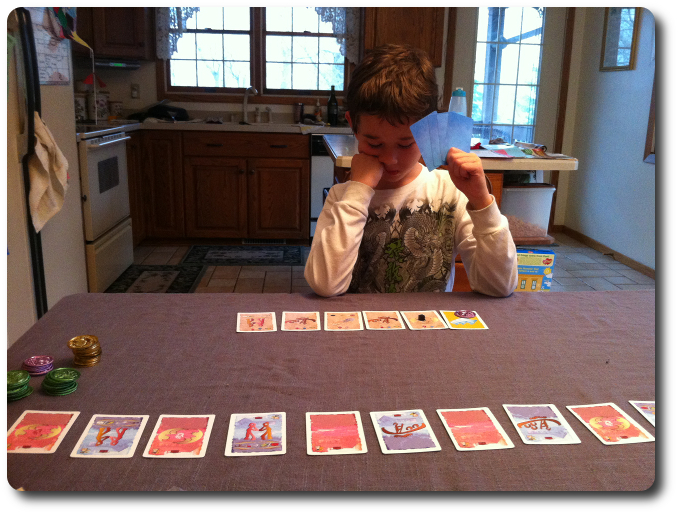
My little geek quietly considers what actions he should take…
The Parent Geeks were delighted with this game. They greatly enjoyed the passive game play between players, but the very real competitive nature the game promoted. The game appealed to the gamer and non-gamer Parent Geeks in equal measure and scaled very well from 2 to 5 players without issue. The game was also found to be an excellent one for not only the Parent Geek’s families but also their peers. Columbia is casual and easy to “pause” if need be, which makes it a great game to bring to a friend’s house when families are getting together with lots of kids. The Parent Geeks had no problem approving Columbia.
The Gamer Geeks enjoyed Columbia for its casual but deep game play, the level of strategy and tactics that game allowed for, and the game’s overall playing speed. While a family will take up to 45 minutes (or longer) to play a single game, the Gamer Geeks whizzed through their games in less than 30 minutes. The Gamer Geeks predicated that Columbia would feel like it was a single-player experience, but this never came to pass. Instead, while each player did work in their own area, they had to constantly come back and compete with each other over the Trading Post cards, while simultaneously managing their own Expedition cards as they counted up the points of their opponents and attempted to out do them. This turned out to be an excellent mix of game mechanisms that made the Gamer Geeks very happy. All the Gamer Geeks voted to approve of Columbia and even went so far as to say it would be welcomed at their table as one of the “main games of the evening”. Now that’s a lot of praise…
I wouldn’t say I am “in love” with Columbia, but my level of fondness for this game is the next best thing. Each game has been a joy and challenging. Every person I have played it with has also enjoyed it, even though they might have lost spectacularly. I think the secret to the game’s success in our play groups is not only its visual appeal, but how dynamic the game feels. This is not a card game where each card played is an island unto itself. Each turn benefits (or is penalized) by the previous hand, and each future turn promises something new. Players can shift their strategy and tactics several times during the game and have a great deal of choice throughout. The game feels big, but is exceedingly easy to manage. You never feel that you are in a corner, but there are times players felt a bit overwhelmed with the choices in front of them. Never to a point of frustration, mind you. Only to a point where they couldn’t determine which of the many paths were the best – and they were all good paths to travel down.
Columbia is an exceedingly well designed game. Some of the game bits are a bit quirky and don’t fit the game’s theme, but everything works. From the petroglyphic artwork that doubles up as action and cube placement spaces to the funny colored money. From the first shuffle to the last victory point counted, the game was outstanding. I highly recommend Columbia to friends, family, and strangers who take the time to engage in me in conversation. Do track and trap this game the first chance you get.
This game was given to Father Geek as a review copy. Father Geek was not paid, bribed, wined, dined, or threatened in vain hopes of influencing this review. Such is the statuesque and legendary integrity of Father Geek.



